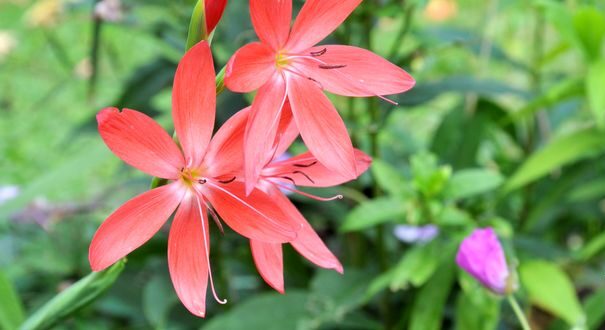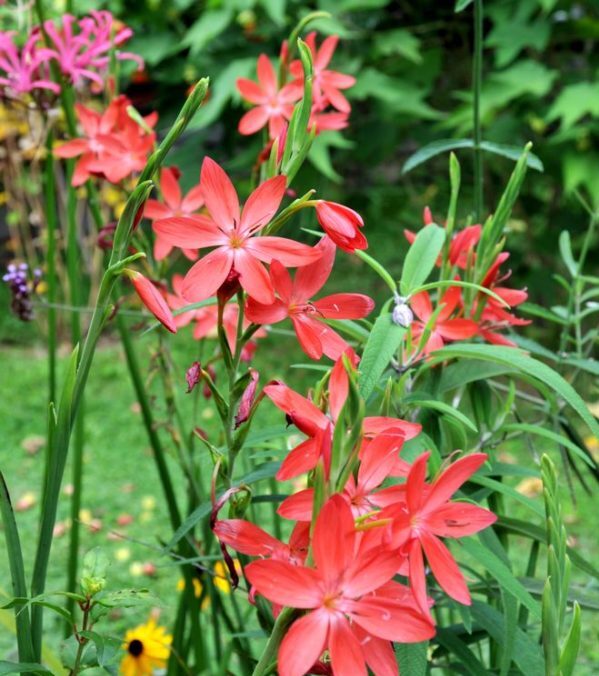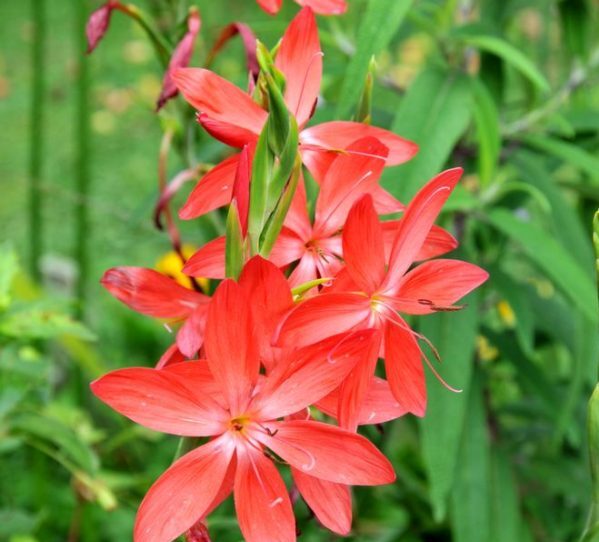
The Kaffir Lily ( Schizostylis coccinea , family Iridaceae) likes to mix genres. Comparable to a low gladiolus for its flower stalks and for the wasp-like size of its ribbon-like leaves, its flowers mimic those of pretty crocuses. Despite its South African origins, this Lily of the Cafres is a very hardy perennial (-10°C) everywhere in the world. How to cultivate and maintain it ?
3 tips for growing the Cafres lily properly
The Cafres lily thrives in moist soil reminiscent of its humid regions of origin. Install it near a body of water.
Divide the clumps regularly to stimulate its vigor and flowering
Use the flowers in bouquets, they last a long time!
Kaffir lily: description
This beautiful perennial plant forms a clump 40 to 70 centimeters high composed of fine, narrow, ribbon-like leaves. The foliage is evergreen in mild climates, semi-evergreen elsewhere.
The stump has many bulblets which stretch and spread laterally by means of stolons.
The flower stalks rise in the middle of the foliage. They each carry between 6 and 10 light red flowers grouped in spikes which open from the end of summer (end of September) until the first frosts, and even beyond in regions with mild winters. These star-shaped, cup-shaped flowers are a godsend for constituting colorful bouquets at a time of year when cut flowers are becoming increasingly rare. They are also very good.

Where to plant the Cafres Lily?
In southern Africa, Schizostylis coccinea naturally inhabits river banks. Take this proven taste for wet soils into account when introducing it. The kaffir lily fears drought, even temporary. It is therefore preferable to plant it in beds or in groups near a source of water (basin, pond, pond, stream or fountain) in the direction of which it can extend its root system and go there to draw the humidity that he loves. The plant will thus resist much better to summers crushed by the sun. The soil, even heavy and clayey, does not matter, as long as it simply maintains a good level of humidity. Plant it in the company of late fall-flowering plants, like the nerine(Nerine bowdenii), asters and even exotic shrubs like the tibouchine d’Urville…
On the exposure side, full sun suits it well even if the Cafres lily tolerates partial shade if necessary.
How to plant the Cafres Lily?
Sowing Lily des Cafres is not really practiced. 3 full years of cultivation are indeed necessary before the first flowers appear.
To save time, Schizostylis is therefore introduced into the garden from pots or by dividing an existing strain .
Plant the buckets or pots in the fall in mild climates, in the spring everywhere else. Dig a hole two to three times larger than the root ball. Loosen the soil well at the bottom and sides. Wedge the clod leaving the top level with the ground. Backfill with a mix of half garden soil, half compost. Finish by tamping and watering gently.

Maintenance of the Cafres Lily
This perennial requires little care.
When vegetation resumes in the spring, add compost to the feet, scratching the soil to make it penetrate well. Pot-grown plants will appreciate a little flower plant food every 15 days. To be carried out only after a copious watering beforehand so as not to burn the roots.
During the flowering period, regularly clean the spent flower spikes to encourage the production and good performance of new flowers.
From December to the end of March, depending on the end of flowering, prune the plant overall by lowering all of its foliage to 10 or 15 centimeters from the ground.
Finally, in regions with cold winters and even if the Lily of the Cafres is rather hardy, do not hesitate to cover the feet with a thick mulch of dead leaves or fern fronds. Potted plants, which are more sensitive, should also be sheltered from frost, ideally in a cold greenhouse.
How to propagate the Cafres Lily?
Schizostylis coccinea spreads naturally over time by sending out rhizomatous roots similar to stolons (like strawberries). If the growing conditions suit it, the Cafres Lily can then become a bit invasive. Do not hesitate to take advantage of this expansive character.
Divide the stumps regularly, every 3 or 4 years, to renew the plants and help them regain more vigour. Remove the stump using a spade fork. Cut the rhizomes at the internodes and replant the shards without delay. A good-sized strain can thus produce 4 to 6.
